Saint-Cannat
| |
|---|---|
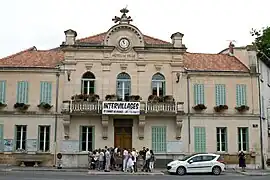 Saint-Cannat Town Hall | |
.svg.png.webp) Coat of arms | |
Location of Saint-Cannat | |
 Saint-Cannat 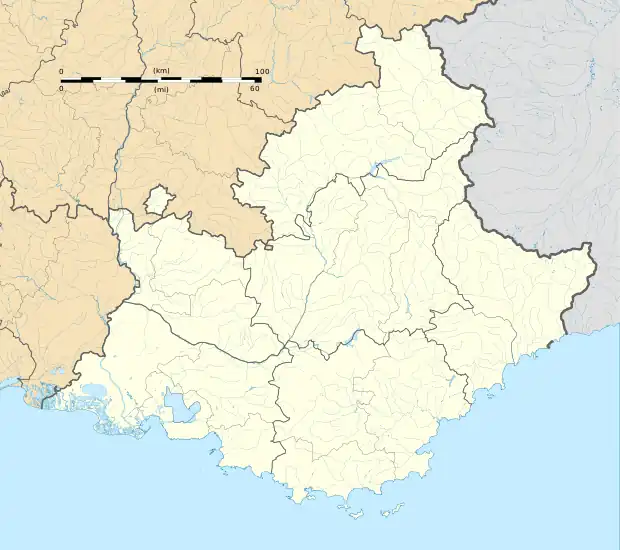 Saint-Cannat | |
| Coordinates: 43°37′12″N 5°17′55″E / 43.62°N 5.2986°E | |
| Country | France |
| Region | Provence-Alpes-Côte d'Azur |
| Department | Bouches-du-Rhône |
| Arrondissement | Aix-en-Provence |
| Canton | Pélissanne |
| Intercommunality | Aix-Marseille-Provence |
| Government | |
| • Mayor (2020–2026) | Jacky Gérard[1] |
| Area 1 | 36.54 km2 (14.11 sq mi) |
| Population | 5,653 |
| • Density | 150/km2 (400/sq mi) |
| Demonym | Saint-Cannadens |
| Time zone | UTC+01:00 (CET) |
| • Summer (DST) | UTC+02:00 (CEST) |
| INSEE/Postal code | 13091 /13760 |
| Elevation | 159–391 m (522–1,283 ft) (avg. 212 m or 696 ft) |
| Website | saint-cannat.fr |
| 1 French Land Register data, which excludes lakes, ponds, glaciers > 1 km2 (0.386 sq mi or 247 acres) and river estuaries. | |
Saint-Cannat (French pronunciation: [sɛ̃ kana]; Occitan: Sant Canat) is a commune in the Aix-Marseille-Provence Metropolis in the Bouches-du-Rhône department in the Provence-Alpes-Côte d'Azur region in Southern France. It is located just northwest of Aix-en-Provence, seat of the larger arrondissement.
History
The village was named after Canus Natus, a fifth century Roman Catholic Saint, who was a Roman clergyman born with white hair, a quirk synonymous with great wisdom at the time.[3] He was buried in Saint-Cannat, although there was no such place at the time, but soon enough several houses were built into a hamlet.[3]
In the twelfth century, Archbishop Pierre mentioned, 'Castrum Santi - Cannati' in a paper.[3]
In the thirteenth century, villagers turned on their archbishop and pledged allegiance to the Lord of the Baux-de-Provence, and then to the Kings of Sicily (namely, Frederic III of Aragon, or perhaps Louis XIII).[3] This, however, only lasted three years.[3] In the same century, the Knights Templar established a settlement there.[3]
Pierre André de Suffren was born here on 17 July 1729.[3] A century later, Alphonse Tavernier, a poet, was born here on 27 November 1852.
On 11 June 1909 a terrible earthquake destroyed almost everything.[3] Shortly after, the houses were re-built in the same architectural style.[3] Both in 1984 and 1994 huge floods ravaged most houses.[3]
It has retained several fountains dating back to the 17th and 18th century, the remains of the medieval ramparts and the chateau, which today houses the town hall and museum.[3] The Route nationale 7 bisects the village.
There is a polo club, Polo Club de Saint Cannat, opened in the 1970s.[4] It organizes the Open d'Aix and the Tournoi de Noel every year.[5]
There is also an entertainment park called Village des automates.[6]
It is also home to the winery Château de Beaupré, started by Baron Emile Double (1869-1938) in 1890.[7]
The creek Budéou flows through the village.
Demographics
|
| ||||||||||||||||||||||||||||||||||||||||||||||||||||||||||||||||||||||||||||||||||||||||||||||||||||||||||||||||||
| Source: EHESS[8] and INSEE (1968–2020)[9] | |||||||||||||||||||||||||||||||||||||||||||||||||||||||||||||||||||||||||||||||||||||||||||||||||||||||||||||||||||
Gallery
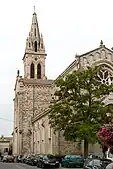 Roman Catholic church
Roman Catholic church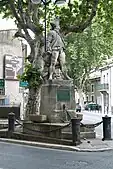 Statue of Pierre André de Suffren
Statue of Pierre André de Suffren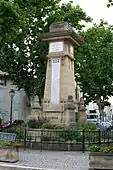 War memorial
War memorial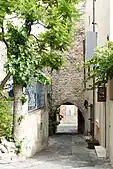 An alley in Saint-Cannat
An alley in Saint-Cannat
References
- ↑ "Répertoire national des élus: les maires" (in French). data.gouv.fr, Plateforme ouverte des données publiques françaises. 13 September 2022.
- ↑ "Populations légales 2021". The National Institute of Statistics and Economic Studies. 28 December 2023.
- 1 2 3 4 5 6 7 8 9 10 11 official website Archived 2007-05-18 at the Wayback Machine
- ↑ Polo Club de Saint Cannat
- ↑ Horace A. Laffaye, The Polo Encyclopedia, Jefferson, North Carolina: McFarland & Company, 2004, p. 330
- ↑ Village des automates
- ↑ History
- ↑ Des villages de Cassini aux communes d'aujourd'hui: Commune data sheet Saint-Cannat, EHESS (in French).
- ↑ Population en historique depuis 1968, INSEE